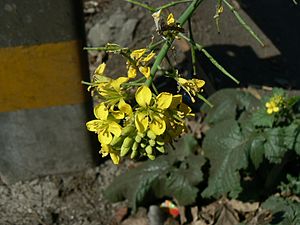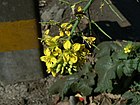Note: This is a project under development. The articles on this wiki are just being initiated and broadly incomplete. You can Help creating new pages.
Brassica juncea
Brassica juncea is an erect. It grows up to 160cm tall when in flower. It is the parent of several distinct forms that are grown for food, oil etc.
Contents
[hide]- 1 Uses
- 2 Parts Used
- 3 Chemical Composition
- 4 Common names
- 5 Properties
- 6 Habit
- 7 Identification
- 8 List of Ayurvedic medicine in which the herb is used
- 9 Where to get the saplings
- 10 Mode of Propagation
- 11 How to plant/cultivate
- 12 Season to grow
- 13 Required Ecosystem/Climate
- 14 Kind of soil needed
- 15 Commonly seen growing in areas
- 16 Photo Gallery
- 17 References
- 18 External Links
Uses
Abscesses, Colds, Lumbago, Rheumatism, Stomach disorders, Skin eruptions, Ulcers, Headache, Bladder, Inflammation, Haemorrhage.
Parts Used
Chemical Composition
Brown and yellow mustard seeds were purchased from local market of Gorakhpur. The fresh and mature berries of B.juncea and S.alba were washed; sun dried and pulverized into a fine powder.[1]
Common names
| Language | Common name |
|---|---|
| Kannada | NA |
| Hindi | Sarson |
| Malayalam | NA |
| Tamil | Kadugu |
| Telugu | NA |
| Marathi | NA |
| Gujarathi | NA |
| Punjabi | NA |
| Kashmiri | NA |
| Sanskrit | NA |
| English | Leaf mustard, Indian mustard |
Properties
Reference: Dravya - Substance, Rasa - Taste, Guna - Qualities, Veerya - Potency, Vipaka - Post-digesion effect, Karma - Pharmacological activity, Prabhava - Therepeutics.
Dravya
Rasa
Guna
Veerya
Vipaka
Karma
Prabhava
Habit
Identification
Leaf
| Kind | Shape | Feature |
|---|---|---|
Flower
| Type | Size | Color and composition | Stamen | More information |
|---|---|---|---|---|
| {{{5}}} |
Fruit
| Type | Size | Mass | Appearance | Seeds | More information |
|---|---|---|---|---|---|
Other features
List of Ayurvedic medicine in which the herb is used
Where to get the saplings
Mode of Propagation
How to plant/cultivate
Originating from the central Asian Himalayas to China, Brassica juncea has long been cultivated and many forms have been developed (see separate records).[3]
Season to grow
Very early spring.
Required Ecosystem/Climate
Ranging from Boreal Wet to Tropical Thorn through Tropical Wet Forest Life Zones, Indian Mustard is reported to tolerate annual precipitation of 500 to 4,200 mm, annual temperature of 6 to 27°C, and pH of 4.3 to 8.3.[4]
Kind of soil needed
Good sandy loamy soil.
Commonly seen growing in areas
Photo Gallery
References
External Links
- Ayurvedic Herbs known to be helpful to treat Abscesses
- Ayurvedic Herbs known to be helpful to treat Colds
- Ayurvedic Herbs known to be helpful to treat Lumbago
- Ayurvedic Herbs known to be helpful to treat Rheumatism
- Ayurvedic Herbs known to be helpful to treat Stomach disorders
- Ayurvedic Herbs known to be helpful to treat Skin eruptions
- Ayurvedic Herbs known to be helpful to treat Ulcers
- Ayurvedic Herbs known to be helpful to treat Headache
- Ayurvedic Herbs known to be helpful to treat Bladder
- Ayurvedic Herbs known to be helpful to treat Inflammation
- Ayurvedic Herbs known to be helpful to treat Haemorrhage
- Herbs with Leaves used in medicine
- Herbs with Flowers used in medicine
- Herbs with Seeds used in medicine
- Herbs with common name in Hindi
- Herbs with common name in Tamil
- Herbs with common name in English
- Habit - Annual
- Index of Plants which can be propagated by Seeds
- Herbs that are commonly seen in the region of Cornfields in Britain
- Herbs
- Pages without herbs images





